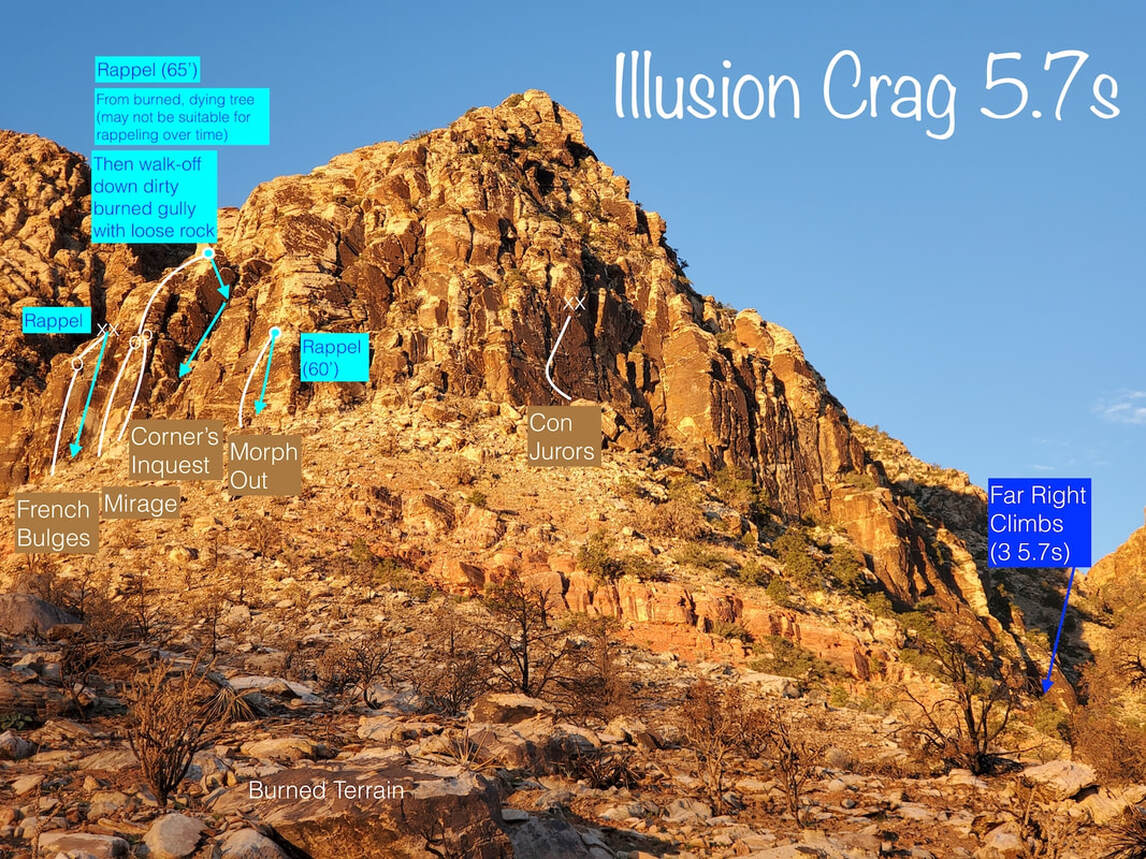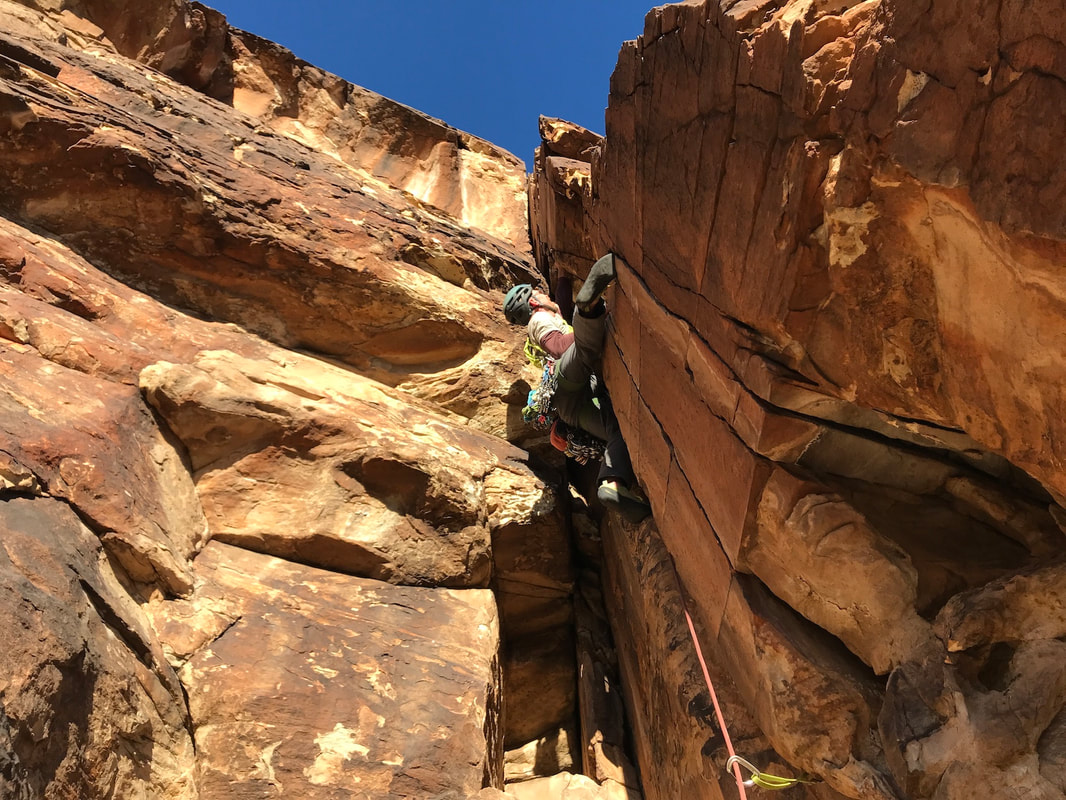Eight 7s, six done
Herbst, Swain, Urioste
Two "What the Fuckers!"
Herbst, Swain, Urioste
Two "What the Fuckers!"
French Bulges
|
Climb: French Bulges (Trad) (5.7)(1 pitch ~80')(Pro to 3")
FA: Nanouk Borche and Joe Herbst, 1973 Wall: Illusion - Left Side Beginner Lead? Probably ok (surprisingly, since this is a Herbst climb. But it is well protected and nicely featured) Conclusion WTF? What the FUN! When you look at this climb from below and you see the name, you anticipate multiple bulges, however because you are climbing in a corner, mostly stemming, the bulges are not really noticeable. We were surprised that, for a Joe Herbst climb, it was pretty straight forward and a solid 5.7. The protection is good and there are nice sized features all the way up.
You can rappel off this climb and avoid the loose, crappy, burned walk-off. |
Mirage
|
Climb: Mirage (Trad) (5.7)(~140', two pitches recommended)(Pro to 5")
FA: Betsy Herbst, Joe Herbst, & Joanne Urioste, 1976 Wall: Illusion Beginner Lead? No! Conclusion WTF? What the FUCK! (But Fun) This is a super interesting, incredibly diverse, and physically demanding climb. It is definitely a WTFr, but it is also fun. Not for the new lead - at all.
This climb moves from the corner into a splitter hand jam (smooth, slick rock) before moving into the tricky off width shown in the photo here. Continue up the off width, then out onto the face (still kind of slick) with some funky moves. Navigate two small roofs. Straight up the roofs is the most challenging, or you can go out right or up the off width to the left for a little easier terrain. Protection can be tricky and intermittent in the upper sections. If others want to top rope this climb, you will need to build an anchor above the roofs - but the anchor is difficult to build and needs large gear and multiple really long slings. Otherwise you will need to have the second follow. Although you could try to stretch this into one long 140-foot pitch, we'd recommend breaking it into two pitches. The rope drag not only would be problematic, you may want to be able to have your second in the line of sight as they go through the challenging first 80-feet (depending on their experience level with the diverse climbing styles needed for this climb.) |
The second pitch is low 5th class terrain and the best place to stop and belay is at a boulder. There are no other options for protection except to sling the boulder.
DESCENT: Scramble to a large, burnt and dying pine tree. It will only be a matter of time before this tree is unsafe to rappel from (see descent option 2 below). Rappel approximately 60-feet into the gully then scramble down the gully. Note that the gully is very loose and dirty from the fire. Make sure no one is below you as you descend. Several good sized rocks dislodged as we descended and they gained significant momentum and would have struck people hanging out near the climbs below.
DESCENT OPTION 2: If we were to return here, we would bring webbing to leave slung around the boulder (the one you belayed from at the top of pitch 2) and rappel from here. This would not only avoid the dying tree, it would also avoid much of the the loose and dangerous gully. (So you might consider bringing a large amount of webbing.)
DESCENT: Scramble to a large, burnt and dying pine tree. It will only be a matter of time before this tree is unsafe to rappel from (see descent option 2 below). Rappel approximately 60-feet into the gully then scramble down the gully. Note that the gully is very loose and dirty from the fire. Make sure no one is below you as you descend. Several good sized rocks dislodged as we descended and they gained significant momentum and would have struck people hanging out near the climbs below.
DESCENT OPTION 2: If we were to return here, we would bring webbing to leave slung around the boulder (the one you belayed from at the top of pitch 2) and rappel from here. This would not only avoid the dying tree, it would also avoid much of the the loose and dangerous gully. (So you might consider bringing a large amount of webbing.)
Corner's Inquest
|
Climb: Corner's Inquest (Trad) (5.7)(~140', two pitches)(micros and RPs, gear to 2")
FA: John Wilder & Larry DeAngelo, 2006) Wall: Illusion Beginner Lead? No. Thin, runout, with tricky pro Conclusion WTF? What the FUNOUT! This is a fun, but thin face climb up the arete. There is very little protection so it is run out in sections. Bring small gear, including micros and RPs (brassies).
This climb is best done in two pitches. The second pitch and descent is the same as Mirage (see DESCENT section above.) |
Morph Out
|
Climb: Morph Out (Trad) (5.7)(1 pitch ~75')(Pro to 4" - a 5" might even be helpful down low)
FA: Donette Swain & Todd Swain, 1994 Wall: Illusion Beginner Lead? No! Conclusion WTF? What the FUCK! The first 20-30 feet of this climb is no joke. It is difficult to protect (decking likely), dirty with loose rock, with awkward, difficult, and strenuous moves. Shorter people are at a clear disadvantage.
Continue up the corner and go out onto the left face. There is actually very little pro here and a fall would be a deck. Before the bulgy/roofy crack, go right and out onto the right side face. The climb gets super easy and is heavily featured (5.3ish) and protectable all the way to the anchor. The anchor is tat, from which you can rappel. If you want to try this climb on top rope, climb Chameleon Pinnacle (5.4 on the face to the right), which leads to the same set of anchors. Bring long slings to set up the TR. |
Con Jurors
|
Climb: Conjurors (Trad) (5.7 in Handren, 5.7+ in MP)(1 pitch ~110', 70m recommended)(Pro to 4")
FA: Raleigh Collins & Brandt Allen, 1994 Wall: Illusion Beginner Lead? Probably not. The start is easy, but unprotectable, so it could be uncomfortable for a new leader. There is an intermediate anchor, which would be a good place to end for a beginner lead. The last section where the crack angles right, after the intermediate anchor, get's thin and tricky in several spots. Conclusion WTF? What the FEISTY! The start of this climb is far to the right of the crack. Go up a low angled ramp to the base of the crack. There is no protection, but the ledge is decent sized. We also experimented with going straight up, which is about a 5.9/5.10a with little pro, and up a small crack to the left, which is protectable and in the 5.7/5.8 range.
|
The main crack up to an intermediate anchor (which is webbing slung through a hole) has huge features and is easily protectable. The climb gets challenging after this intermediate anchor, when the crack starts angling off to the right. This area is where the #4 comes in handy. The features thin out considerably the higher you get. There are bolted anchors at the top. A 70m rope is needed to rappel down.
Sendable
|
Climb: Sendable (Trad) (5.7)(1 pitch ~95')
FA: Unknown Wall: Illusion Beginner Lead? No. Conclusion WTF? What the FEISTY! This climb is posted as 40 feet in Mountain Project and this is incorrect! The main part of the climbing may be 40-feet, but where you would set up an anchor for top roping and belay up the second to be able to descend, is about 95 feet.
After you reach the top of the crack in this photo, the rock becomes crappy, slabby, and low angled. The only place to set up a top rope and belay is at a large boulder, which requires long slings and creative placements. If you top rope, the rope will drag significantly along the rock (we don't recommend TRing - but if you do bring a 70m)(Mountain Project talks about top roping several lines across the face, but having appropriate directionals from the anchor would be a challenge - there are dead tress and loose rocks all across the crappy slab.) The start of this climb is unprotectable steep slab. It is more challenging than it looks and we'd estimate to be about a 5.9. A fall would be into pokey oaks. The first piece of pro is around 20 feet up. Then the climb gets easy for a section, with creative pro, and becomes somewhat feisty again near the top where the crack goes straight up in the photo. After that, it is low angled junk to the boulder. |
Climb Stats to Date
|
DATE OF CLIMB: November 21 & December 3, 2021
WALLS HIT: 1 NUMBER OF 5.7 CLIMBS: 6 NUMBER OF 5.7 PITCHES: 7 NUMBER OF FALLS: 0 NUMBER OF TAKES: 0 VERTICAL FEET CLIMBED: 580' DIRTY UNDERWEAR ENCOUNTERED: 0 TOTAL CLIMBS SO FAR: 178 TOTAL PITCHES SO FAR: 233 TOTAL 5.7 VERTICAL FEET ON THE TOUR SO FAR: 20,550 NUMBER OF CLIMBS REMAINING: 60 (out of 238) VERTICAL FEET REMAINING: 31,057' DIRTY UNDERWEAR ENCOUNTERED TO DATE: 8 |
FALLS SO FAR:
|
|








